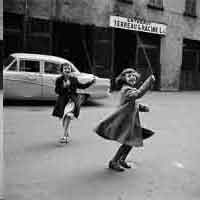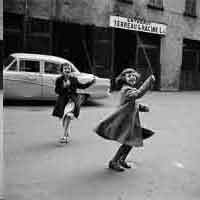Vivian Maier : the real in everyday banality

Francesco Carelli
“For all the dinners are coke, the plates and cups washed, the children sent to school and gone out into the world. All has vanished.. No biography or history has a word to say about it. “
Virginia Woolf, A Room of One’s Own
The Old Arengario, the Medieval Town Hall in Monza (Milano) hosts till January 2017, and important exhibition from Vivian Maier.
 Vivian Maier (1926 – 2009) worked as a governess for more than four decades as of the beginning of the 1950s. Her entire life went inevitably unnoticed, until her photographic corpus was discovered recently (in 2007): a colossal work consisting of more than 120,000 negatives, super 8mm and 16mm films, various recordings, miscellaneous photographs, and a multitude of undeveloped films. In spite of the fact that there has not been enough time to compare the different scholarly and critical analyses of this work, it seemed appropriate to show a non-exhaustive yet representative selection of photographer’s images.
Vivian Maier (1926 – 2009) worked as a governess for more than four decades as of the beginning of the 1950s. Her entire life went inevitably unnoticed, until her photographic corpus was discovered recently (in 2007): a colossal work consisting of more than 120,000 negatives, super 8mm and 16mm films, various recordings, miscellaneous photographs, and a multitude of undeveloped films. In spite of the fact that there has not been enough time to compare the different scholarly and critical analyses of this work, it seemed appropriate to show a non-exhaustive yet representative selection of photographer’s images.
It is complete accident that the world has stumbled on her work, it could very easily have been destroyed without anyone knowing about it.
In her spare time, Vivian Maier photographed the street, people, objects, landscapes; ultimately, she photographed what she saw abruptly, to put it simply. She knew how to capture her time for a fraction of a second. She narrated the beauty of ordinary things, seeking the imperceptible cracks and elusive inflections of the real in everyday banality.
Her world was the others, the unknown, anonymous people, whom Vivian Maier touched upon for a second, so that when she recorded with her camera was first a matter of distance – that same distance that turned those characters into the protagonists of an anecdote of no importance. She stays at the threshold and even beyond the scene she photographs, never on this side, so as not to be invisible. She takes part in what she sees and becomes a subject herself.
The reflection of her face, her shadow that extends on the ground, the figure of her silhouette, are projected in the perimeter of the photographic image.
With her Rolleiflex she had just 12 shots and then had to reload the film…not easy in the open air. She shot about a roller film a day; she spent virtually all her earnings on film equipment and storage. Unlike most photographers, Vivian tended to take just one shot and move on; her hit rate was phenomenal. When she shot her photos, she would be completely and utterly focused, it was an instant, in absolute concentration, then it will be done.
She does wonderful portraits of distinctive characters; she is able to capture in a moment, everything is moving very fast, she is very much like a poet who is trying to just observe very carefully for personal reasons to look at the world and locate what is important to her, what interests her, capture it in a photograph. The camera is an instrument of detection: we photograph not only what we know, but also what we don’t know.
Here we really get the sense of a day in the life on a diary here and we can see how she moves through the street. Putting all on a row, we would see one woman’s life unfolding on film. In this way, we have an unbroken string of images of what she saw, of what her experiences were. This is what her big project was: it was her life, it was experiencing life through photography.
It is really about being alive to the world, and seeing yet another moment of consciousness in which an awaken state is all about. One is privileged to see that life is doing this for you. You are dealing with the disappearing moment: it is there and it is gone and the only way that is recognised as having happened is you observing it, knowing it and photographing it. So, you are the repository and it is great if you can make prints out of it and share this, but at a certain point, if you have done it long enough, really you have to. It is for you, it is just for you.

